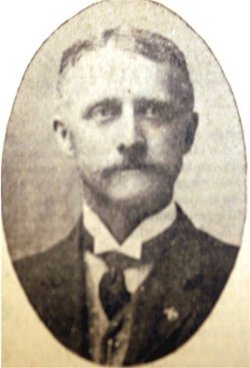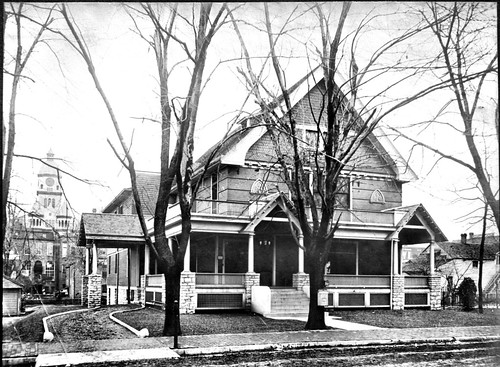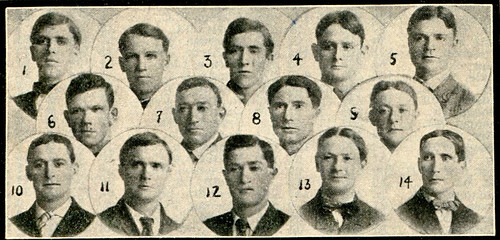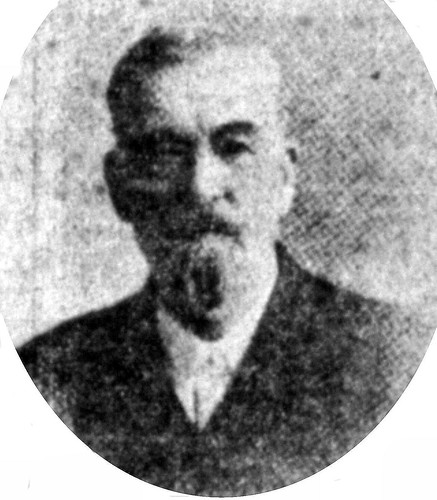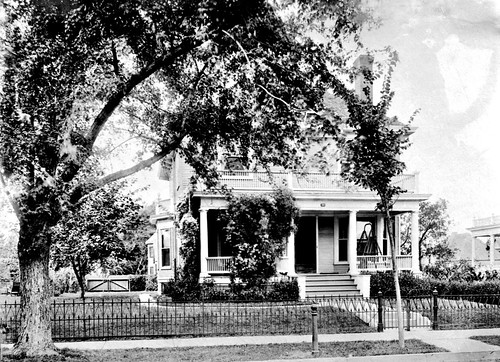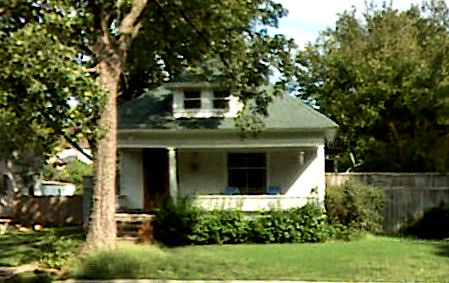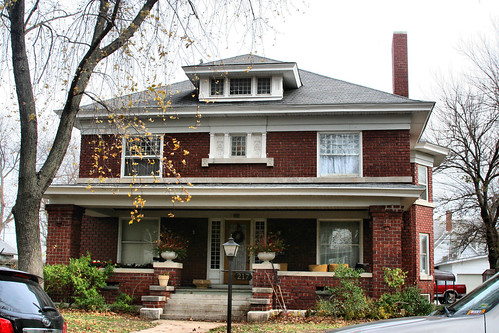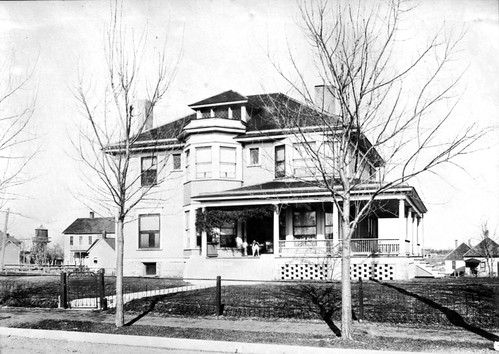
The Leslie W. Winter house
Our next entry in the Garstang & Rea series is the Leslie W. Winter house of Joplin at 402 N. Wall. Mr. Winter was a popular fellow and two biographies are found in the tomes of Joplin history. As such, we’ve decided to post both of them here. The first is from A History of Jasper County, Missouri, and Its People, by Joel T. Livingston, which says of Leslie Winter:
Standing forth distinctively as one of the representative and honored citizens of Joplin, Leslie W. Winter, head of the Winter Construction Company, has been a conspicuous figure in developing the mineral resources of this section of the state, and is now busy fulfilling contracts with several large railway corporations, his wisdom and discrimination in the conduct of extensive operations giving him high prestige as a man of affairs. He was born, February 13, 1868, at Cleveland, Ohio, in Cuyahoga county, which was also the birthplace of his father, Malitus C. Winter, and of his Grandfather Winter. He is of thrifty New England ancestry, the branch of the Winter family from which he is descended having been prominent in Massachusetts in colonial times.
Born January 10, 1841, near Cleveland, Malitus C. Winter grew to man’s estate in that vicinity, and subsequently served four years in the Civil war, belonging to an Ohio regiment. He was afterwards there engaged in tilling the soil until 1870, when he moved to Elk Falls, Kansas, and having acquired title to large tracts of valuable land engaged in farming on an extensive scale. Accumulating considerable wealth as a farmer and stock-raiser, he came with his family to Jasper county, Missouri, and has since lived retired from active business in Joplin, being a highly respected citizen of his community. He married Nettie Johnson, who was born at Rock Island, Illinois, where her parents were pioneer settlers.
Brought up in Kansas, Leslie W. Winter was educated in the public schools of Douglass. Making his first appearance in Joplin, Missouri, in 1884, then a beardless boy of sixteen years, he began mining on his own account, the mineral deposits of lead and zinc giving him a rich field of labor, and in addition to looking after his own affairs, he soon began managing mines for others. He opened several good mines, in the meantime establishing a good reputation for expert work and accurate knowledge concerning the location and value of minerals.
Subsequently, having obtained recognition as a dominant power in the operation of large holdings, Mr. Winter was made superintendent of the Old Colony Zinc & Smelting Company properties, which was organized in Boston, Massachusetts, in 1899, by some of the most conservative and reliable business men of that and neighboring cities for the purpose of developing the mineral resources of southeastern Missouri. These men gave their personal attention to the affairs of the company, which included among its officers and directors Col. Albert Clarke, Elias J. Bliss, and George W. Parker, of Boston, Hon. P. C. Cheney, of Manchester, New Hampshire, Hon. D. Russell Brown, of Providence, Rhode Island, and other men of prominence in mining circles. Among other properties owned by this company was the Yale mine, at Webb City, Missouri, the White Rose, at Galena, Kansas, the Black Jack, and it also had a fee to two hundred and thirty-seven and a half acres upon which it had erected four mills, Mr. Winter having been largely instrumental in securing these mines and mills from the Old Colony Zinc & Smelting Company.
Mr. Winter was not only general manager of these extensive mining properties, but a director, and the secretary of the company. He was likewise secretary of the Joplin Improvement & Construction Company, of which Mr. E. J. Overly was president. Since the formation of the Winter Construction Company, Mr. Winter has carried out some very valuable contracts, and has just now closed a contract with the Kansas City Southern Railway Company, the Atchison, Topeka & Santa Fe Railway Company, and with the Missouri Pacific Railway Company for a large amount of construction work. In addition to holding the presidency of the Winter Construction Company, of Joplin, Mr. Winter is president of a coal and coke company, of Arkansas, and a director of the Federal Trust Company, of St. Louis. He is a sound Republican in politics, ever willing to do all in his power to promote the growth and insure the success of his party, and has served as constable of Joplin, and was deputy sheriff one term. Fraternally he is a member of the Joplin Lodge, Benevolent and Protective Order of Elks, and of Joplin Lodge, Modern Woodmen of America.
Mr. Winter married, August 7, 1892, in Joplin, Ella Coleman, a daughter of William H. Coleman. Mr. Coleman was born and bred in New York City, and as a young man migrated to Kansas. Joining the Union Army at the outbreak of the Civil war, he served as captain of a Kansas company, and at the Battle of Shiloh was severely wounded. After the war, and his recovery from his wound, he served as a member of the Kansas Senate two terms, and was very prominent in public affairs, his ability making him a fit leader for the people of his state. Mr. and Mrs. Winter have one child, Nera, born September 10, 1893, is now attending the Joplin High School.
A man of sterling integrity and worth, conducting all of his transactions by the strictest principles of honor, Mr. Winter has gained the trust and confidence of the business world, and the esteem and good will of his fellowmen. He is fond of all out-door sports, his particular hobby being base ball. He is a lover of good horses, of which he has several, and he and his wife, who is an expert horsewoman, and an easy, graceful rider, take long rides in and around Joplin. Both have hosts of friends, and their beautiful home is a center of social activity.
The second biography comes from The Biographical Record of Jasper County by Malcom G. McGregor, has this to say of the life of Leslie W. Winter:
Honored and respected by all, there is no man in Jasper county who occupies a more enviable position in mining and financial circles than Leslie W. Winter, not alone on account of the brilliant success he has achieved, but also on account of the honorable, straightforward business policy he has ever followed. He possesses untiring energy, is quick of perception, forms his plans readily and is determined in their execution; and his close application to business and his excellent management have brought to him the high degree of prosperity which to-day is his. Since 1884 he has been connected with mining interests in Jasper county, and has done much toward the development of the mineral resources of this portion of the state.
Mr. Winter represents one of the old families of Ohio, his grandfather, his father and himself all having been born in Cuyahoga county, while the ancestry of the family were originally from Massachusetts. The father. M. C. Winter, is now a resident of Joplin. He married Miss Nettie Johnson, a native of Rock Island county, Illinois, where her people were early settlers. Mr. Winter, of this review, has spent the greater part of his life in the west, having become a resident of Elk Falls, Kansas, in the early ’70s. In 1884 he arrived in Jasper county. He was then hardly more than a boy, but he began mining on his own account, and the rich mineral deposits of lead and zinc have since given him a field of labor. He began mining on his own account and also managed several mines for others. He opened some good mines and established a reputation for expert work and accurate knowledge concerning the location and value of minerals.
Mr. Winter has devoted his entire life to this line of work, and his close application and unfaltering determination have enabled him to overcome all difficulties and work his way steadily upward. He is now superintendent of the Old Colony Zinc & Smelting Company, of Boston, Massachusetts, which was organized in 1899, and is operating extensively in the rich mineral fields of southwestern Missouri. It is composed of some of the most conservative and reliable business men of Boston and vicinity, who give their personal attention to the affairs of the company. The following are included in the list of officers and directors: Colonel Albert Clarke, Elias J. Bliss and George W. Parker, of Boston; Hon. P. C. Cheney, of Manchester, New Hampshire; Hon. D. Rnsell Brown, of Providence, Rhode Island; H. P. Stimpson, of Boston; and L. W. Winter, who has been actively engaged in zinc mining in the Joplin district for the past twenty years.
The company owns at Neck City, in this county, one of the most flourishing camps in southwestern Missouri, having the fee to two hundred and thirty-seven and a half acres of land, upon which there are four mills. The company has a shaft seven by fourteen feet and two hundred and eighty-five feet in depth–the deepest in southwestern Missouri. They are drifting at two hundred and eighty feet in excellent ore, and the value of their property is indicated by the statement of George B. Paxton, a mining engineer, who says: “In my opinion it will prove richer than any other similar sized tract in this district,” while P. L. Crossman, who has been drilling in all parts of the district for over thirty years, and who did the drilling on this ground, says: “This is, to the best of my knowledge and information, the greatest discovery of the best continuous body of paying ore ground in this mineral district.”
Ever since its organization the Old Colony Zinc and Smelting Company has paid regular quarterly dividends at the rate of ten per cent per annum. At Webb City the company has a lease on forty lots in the Missouri zinc fields, and are operating the Harvard mine and mill, the mine being one of the best producers in the locality, running forty tons of ore per week. They also own the Yale mine at Webb City, and at Galena, Kansas, have the White Rose mine and mill and ten lots of the Murphy land. They also have the Black Jack mine on land belonging to the South Side Mining Company and all of these mines are in operation.
The company is one of the strongest and is operating among the most extensive in the district. Mr. Winter was largely instrumental in securing these mines and mills and the land, and of the Old Colony Zinc & Smelting Company he is not only general manager but is also a director and the secretary of the company. He is also secretary and treasurer of the Joplin Street Improvement & Construction Company, of which E. J. Overley is president and A. G. Jennings vice-president and general manager. This company now has under construction ninety miles of railroad and has two contracts for constructing sewers in East Joplin that will pay twelve thousand dollars. Their office is in the Bank of Joplin.
Mr. Winter was married in Joplin, in 1892, to Miss Ella Coleman, of this city, but formerly of Topeka, Kansas. She is a daughter of William H. Coleman, who was born in New York City and removed to Kansas at an early day. He was there at the time of the outbreak of the Civil war, and, joining the Union army, he served as captain of a Kansas company. After the war he was for two terms a member of the state senate and was very prominent and influential in public affairs owing to his ability and fitness for leadership. Unto Mr. and Mrs. Winter has been born but one child, Neva, who is now in her eighth year.
The name of Mr. Winter figures prominently in connection with political interests in southwestern Missouri.. He is firm and loyal in his support of Republican principles, and does all in his power to promote the growth and insure the success of the party. He has been chairman of the Republican congressional committee for the fifteenth district and also chairman of the Republican city committee. He served for one term as deputy sheriff of the county and also as constable for two years. Socially he is connected with the Independent Order of Odd Fellows and with the Modern Woodmen of America, and in both organizations he enjoys the high regard of his brethren. The career of Leslie Winter has ever been such as to warrant the trust and confidence of the business world, for he has ever conducted all transactions on the strictest principles of honor and integrity. His devotion to the public good is unquestioned and arises from a sincere interest in the welfare of his fellow men.
We’re also happy to say that the Leslie W. Winter House still stands:
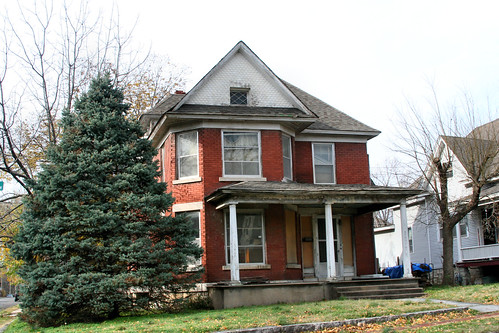
The Leslie Winter House today.

